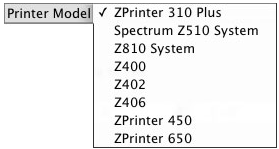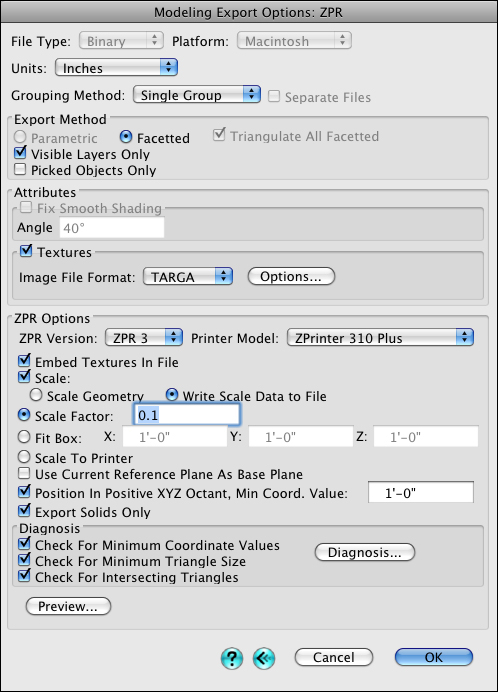ZPR
ZPR is a file format that is used by 3D printers from Z Corporation (www.zcorp.com). 3D prints are made by spreading a thin layer of powder on the print bed. Then, using inkjet printer technology, a binder is “printed” on the powder which solidifies the powder. This printing process is done one cross-section at a time until the full 3D model is printed. To print a form•Z model, the model is exported as a ZPR file. The exported file is then loaded into Z Corporation’s Zprint software which drives the printer.
This process imposes many of the same restrictions as any other rapid prototyping process. The model must be described by one or more closed volumes. Independent surfaces are not allowed. Overlapping or intersecting volumes are allowed but in some cases may result in anomalies in the printed model. To avoid any anomalies, volumes should intersect at facetted face edges. ZPR files only contain triangular faces; consequently, form•Z decomposes all the faces of an object before the object is exported. The maximum size of the exported model is limited by the specific printer model to be used. Unlike STL, supporting structures are not needed in ZPR files. Z Corporation's Zprint software will add these.
Importing ZPR Files
A ZPR file is imported into form•Z in the standard manner. The Modeling Import Options: ZPR dialog contains two format specific options, in addition to the common options.
The Modeling Export Options: ZPR dialog.
Ignore File’s Scale Data: ZPR files contain a transform which scales (and can also rotate and translate) all geometry in the file. This allows original model vertex coordinates to be preserved while transforming the model to fit within the physical limits of the printer. Normally when a ZPR file is imported into form•Z, the geometry is transformed as specified by the file. When this option is selected, the geometry will not be transformed and the original vertex coordinates will be imported.
Scale Factor: X, Y, Z: The scale factors entered in these fields are applied to the geometry in addition to the file’s transform (unless Ignore File’s Scale Data is selected). If no scaling is needed, these values should be kept to 1.0, which are the default values.
Exporting ZPR Files
The content of a form•Z project is exported as a ZPR file in the standard manner. When exporting to ZPR, the active window must be a modeling window, as drafting elements can not be exported to ZPR. The desired options are set in the Modeling Export Options: ZPR dialog, which contains a number of format specific options.
The ZPR specific export options.
ZPR Version: The version of the format can be selected from this pop up menu. ZPR v. 3 and later contain a specification for the type of units used in the file (Metric or English). Version 2 files do not have this information, thus when version 2 files are opened, the ZPR File Units dialog is invoked for telling form•Z what units the ZPR data is in. Select Inches, Feet, Centimeters, or Meters and click OK.

The Printer Model menu.
Printer Model: A printer model can be selected from this pop up menu. This information is used to determine the size of the printer bed and may cause the model to be sectioned into several zpr files. Known printer models are listed in the menu.
Embed Textures In File: When this option is selected, the model’s textures are embedded (contained) in the exported ZPR file. This can result in larger ZPR files, however, it has the advantage that all of the information necessary to print the model is contained in a single file. When this option is not selected, the textures are kept in separate texture files. The location and format of these is controlled by the options in the Textures section above. The Embed Textures In File option is enabled and is on by default when ZPR version 3 (or later) is selected. This option can not be disabled when exporting ZPR version 2 files as this version only supports embedded textures.
Scale: Models printed on Z Corporation printers are limited to a certain size, which may make it necessary to scale the model when it is exported. This can be done by selecting the Scale option and entering the appropriate scaling parameters.
Scale Geometry: ZPR files contain a transform which scales (and can also rotate and translate) all geometry in the file. This allows original model vertex coordinates to be preserved while transforming the model to fit within the physical limits of the printer. When this option is selected, this transform is set to unity and the geometry of the model is scaled.
Write Scale Data To File: When this option is selected, the scale data defined here is written to the ZPR transform and original vertex coordinates are exported.
Scale Factor: When this option is selected, the scale factor contained in its field will be uniformly applied in all directions to the model.
Fit Box: When this option is selected, the model is scaled to fit in a bounding box whose size is determined by the numeric values contained in the X, Y, and Z fields.
Scale To Printer: When this option is selected, the model is scaled to fit within the printer bed as specified by the printer chosen in the Printer Model menu. When this option is selected, the model will not be split up and will be exported as a single ZPR file.
Use Current Reference Plane As Base Plane: When this option is selected, the model is rotated so that the current reference plane is aligned with the print bed. Layers of the printed cross-sections will be parallel to this plane.
Position In Positive XYZ Octant: When this option is selected the model is translated such that all it’s coordinates take on positive values and no coordinate value is less than that specified in the Min. Coord. Value field.
Export Solids Only: When this option is selected (the default), only solid objects are exported.
The Diagnosis and Preview options are identical to STL.

